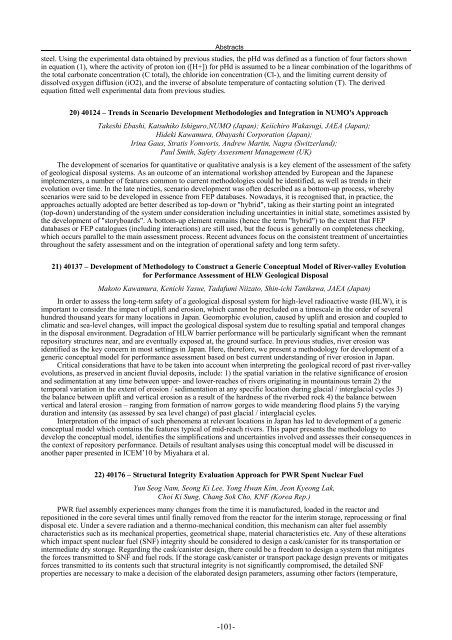ASME Message
ASME Message
ASME Message
You also want an ePaper? Increase the reach of your titles
YUMPU automatically turns print PDFs into web optimized ePapers that Google loves.
Abstracts<br />
steel. Using the experimental data obtained by previous studies, the pHd was defined as a function of four factors shown<br />
in equation (1), where the activity of proton ion ([H+]) for pHd is assumed to be a linear combination of the logarithms of<br />
the total carbonate concentration (C total), the chloride ion concentration (Cl-), and the limiting current density of<br />
dissolved oxygen diffusion (iO2), and the inverse of absolute temperature of contacting solution (T). The derived<br />
equation fitted well experimental data from previous studies.<br />
20) 40124 – Trends in Scenario Development Methodologies and Integration in NUMO's Approach<br />
Takeshi Ebashi, Katsuhiko Ishiguro,NUMO (Japan); Keiichiro Wakasugi, JAEA (Japan);<br />
Hideki Kawamura, Obayashi Corporation (Japan);<br />
Irina Gaus, Stratis Vomvoris, Andrew Martin, Nagra (Switzerland);<br />
Paul Smith, Safety Assessment Management (UK)<br />
The development of scenarios for quantitative or qualitative analysis is a key element of the assessment of the safety<br />
of geological disposal systems. As an outcome of an international workshop attended by European and the Japanese<br />
implementers, a number of features common to current methodologies could be identified, as well as trends in their<br />
evolution over time. In the late nineties, scenario development was often described as a bottom-up process, whereby<br />
scenarios were said to be developed in essence from FEP databases. Nowadays, it is recognised that, in practice, the<br />
approaches actually adopted are better described as top-down or "hybrid", taking as their starting point an integrated<br />
(top-down) understanding of the system under consideration including uncertainties in initial state, sometimes assisted by<br />
the development of "storyboards". A bottom-up element remains (hence the term "hybrid") to the extent that FEP<br />
databases or FEP catalogues (including interactions) are still used, but the focus is generally on completeness checking,<br />
which occurs parallel to the main assessment process. Recent advances focus on the consistent treatment of uncertainties<br />
throughout the safety assessment and on the integration of operational safety and long term safety.<br />
21) 40137 – Development of Methodology to Construct a Generic Conceptual Model of River-valley Evolution<br />
for Performance Assessment of HLW Geological Disposal<br />
Makoto Kawamura, Kenichi Yasue, Tadafumi Niizato, Shin-ichi Tanikawa, JAEA (Japan)<br />
In order to assess the long-term safety of a geological disposal system for high-level radioactive waste (HLW), it is<br />
important to consider the impact of uplift and erosion, which cannot be precluded on a timescale in the order of several<br />
hundred thousand years for many locations in Japan. Geomorphic evolution, caused by uplift and erosion and coupled to<br />
climatic and sea-level changes, will impact the geological disposal system due to resulting spatial and temporal changes<br />
in the disposal environment. Degradation of HLW barrier performance will be particularly significant when the remnant<br />
repository structures near, and are eventually exposed at, the ground surface. In previous studies, river erosion was<br />
identified as the key concern in most settings in Japan. Here, therefore, we present a methodology for development of a<br />
generic conceptual model for performance assessment based on best current understanding of river erosion in Japan.<br />
Critical considerations that have to be taken into account when interpreting the geological record of past river-valley<br />
evolutions, as preserved in ancient fluvial deposits, include: 1) the spatial variation in the relative significance of erosion<br />
and sedimentation at any time between upper- and lower-reaches of rivers originating in mountainous terrain 2) the<br />
temporal variation in the extent of erosion / sedimentation at any specific location during glacial / interglacial cycles 3)<br />
the balance between uplift and vertical erosion as a result of the hardness of the riverbed rock 4) the balance between<br />
vertical and lateral erosion – ranging from formation of narrow gorges to wide meandering flood plains 5) the varying<br />
duration and intensity (as assessed by sea level change) of past glacial / interglacial cycles.<br />
Interpretation of the impact of such phenomena at relevant locations in Japan has led to development of a generic<br />
conceptual model which contains the features typical of mid-reach rivers. This paper presents the methodology to<br />
develop the conceptual model, identifies the simplifications and uncertainties involved and assesses their consequences in<br />
the context of repository performance. Details of resultant analyses using this conceptual model will be discussed in<br />
another paper presented in ICEM’10 by Miyahara et al.<br />
22) 40176 – Structural Integrity Evaluation Approach for PWR Spent Nuclear Fuel<br />
Yun Seog Nam, Seong Ki Lee, Yong Hwan Kim, Jeon Kyeong Lak,<br />
Choi Ki Sung, Chang Sok Cho, KNF (Korea Rep.)<br />
PWR fuel assembly experiences many changes from the time it is manufactured, loaded in the reactor and<br />
repositioned in the core several times until finally removed from the reactor for the interim storage, reprocessing or final<br />
disposal etc. Under a severe radiation and a thermo-mechanical condition, this mechanism can alter fuel assembly<br />
characteristics such as its mechanical properties, geometrical shape, material characteristics etc. Any of these alterations<br />
which impact spent nuclear fuel (SNF) integrity should be considered to design a cask/canister for its transportation or<br />
intermediate dry storage. Regarding the cask/canister design, there could be a freedom to design a system that mitigates<br />
the forces transmitted to SNF and fuel rods. If the storage cask/canister or transport package design prevents or mitigates<br />
forces transmitted to its contents such that structural integrity is not significantly compromised, the detailed SNF<br />
properties are necessary to make a decision of the elaborated design parameters, assuming other factors (temperature,<br />
-101-


